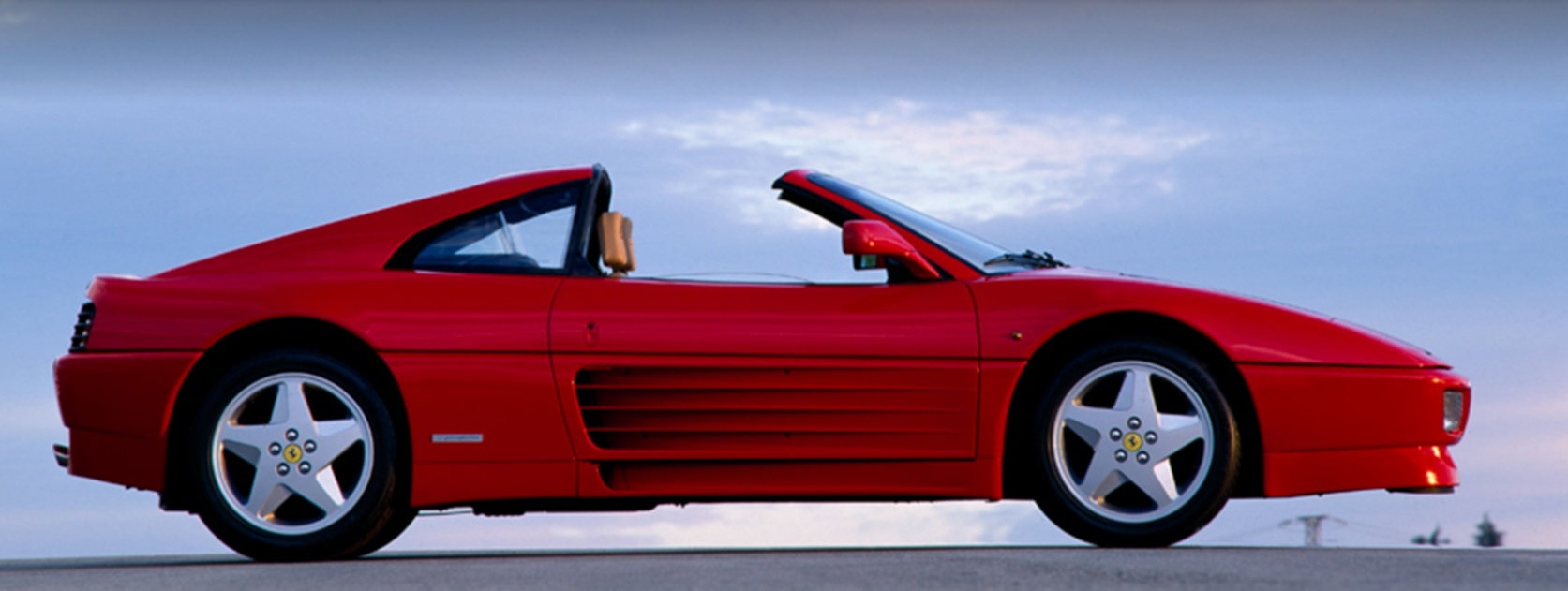

Targa, 2 Doors, 2 Seats
12.7 l/100 km 18.52 US mpg
20 l/100 km 11.76 US mpg
9.6 l/100 km 24.5 US mpg
320 Hp @ 7200 rpm.
94 Hp/l
280 km/h 173.98 mph
3405 cm3
207.79 cu. in.
8, V-engine
Rear wheel drive,
4230 mm
166.54 in.
1894 mm
74.57 in.
1370 kg
3020.33 lbs.
| Brand | Ferrari |
|---|---|
| Model | 348 (Targa) |
| Version | 348 GTS |
| Engine version | 3.4 V8 (320 Hp) |
| Year production start | 1993 |
| Year production end | 1995 |
| Vehicle type | Targa |
| Horsepower RPM | 320 Hp @ 7200 rpm. |
| Acceleration 0 - 100 kmh sec | 5.4 sec |
| Curb weight kg -lbs total |
1370 kg3020.33 lbs. |
| Overall length mm - inch |
4230 mm166.54 in. |
| Doors | 2 |
| Top Speed | 280 km/h 173.98 mph |
| Designation model | F119 |
|---|---|
| Cam configuration | DOHC |
| Engine position and orientation | Middle, Longitudinal |
| Cylinders | 8 |
| Position of cylinders | V-engine |
| Displacement (liters) |
3405 cm3207.79 cu. in. |
| Eng. horsepower RPM | 320 Hp @ 7200 rpm. |
| Horsepower per litre | 94 Hp/l |
| Weight / horsepower kg/hp - hp/tons |
4.3 kg/Hp233.6 Hp/tonne |
| Weight / torque kg/Nm - Nm/tons | 4.2 kg/Nm, 236.5 Nm/tonne
4.2 kg/Nm236.5 Nm/tonne |
| Torque Nm RPM lb-ft RPM |
324 Nm @ 5000 rpm.238.97 lb.-ft. @ 5000 rpm. |
| Bore (mm in) |
85 mm3.35 in. |
| Stroke (mm in) |
75 mm2.95 in. |
| Compression ratio | 10.8 |
| Fuel delivery system | Multi-point indirect injection |
| Fuel type | Petrol (Gasoline) |
| Valvetrain | 4 |
| Engine aspiration | Naturally aspirated engine |
| Engine oil liters | quarts |
11 l11.62 US qt | 9.68 UK qt |
| Engine coolant |
20 l21.13 US qt | 17.6 UK qt |
| Powertrain architecture | Internal Combustion engine |
| Engine location | Middle, Longitudinal |
| Drive configuration | Rear wheel drive |
|---|---|
| Transmission | 5 |
| Front brakes | Ventilated discs |
|---|---|
| Rear brakes | Ventilated discs |
| Anti-lock brake system | ABS (Anti-lock braking system) |
| Steering type | Steering rack and pinion |
|---|---|
| Turning diameter m - ft |
12.1 m39.7 ft. |
| Front suspension | Coil spring, Double wishbone, Transverse stabilizer |
|---|---|
| Rear suspension | Helical spring, Double wishbone, Transverse stabilizer |
| Wheels size | Front wheel tires: 215/50 ZR17 |
|---|---|
| Wheels rims | Front wheel rims: 7.5J x 17 |
| Passengers seats | 2 |
|---|---|
| Trunk space min liter | cu. Ft. |
200 l7.06 cu. ft. |
| Overall length mm - inch |
4230 mm166.54 in. |
|---|---|
| Overall width mm -inch |
1894 mm74.57 in. |
| Overall height mm -inch |
1170 mm46.06 in. |
| Wheelbase mm - inch |
2450 mm96.46 in. |
| Track width front mm - inch |
1502 mm59.13 in. |
| Track width rear mm - inch |
1578 mm62.13 in. |
| Curb weight kg -lbs total |
1370 kg3020.33 lbs. |
|---|---|
| Gross weight kg -lbs total |
1680 kg3703.77 lbs. |
| Capacities kg - lbs |
310 kg683.43 lbs. |
| Fuel tank liters | gallons |
88 l23.25 US gal | 19.36 UK gal |
| City l/100km - mpg |
20 l/100 km11.76 US mpg |
|---|---|
| Highway l/100 km - mpg |
9.6 l/100 km24.5 US mpg |
| Combined l/100 km - Mpg |
12.7 l/100 km18.52 US mpg |
| Autonomy km (combined use) | 733 |
8 CYLINDER V-Engine
https://www.thecarspec.net/components/engine/8-cylinders-v